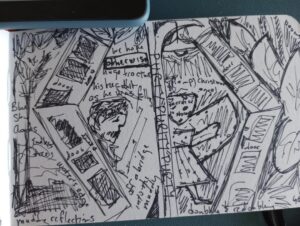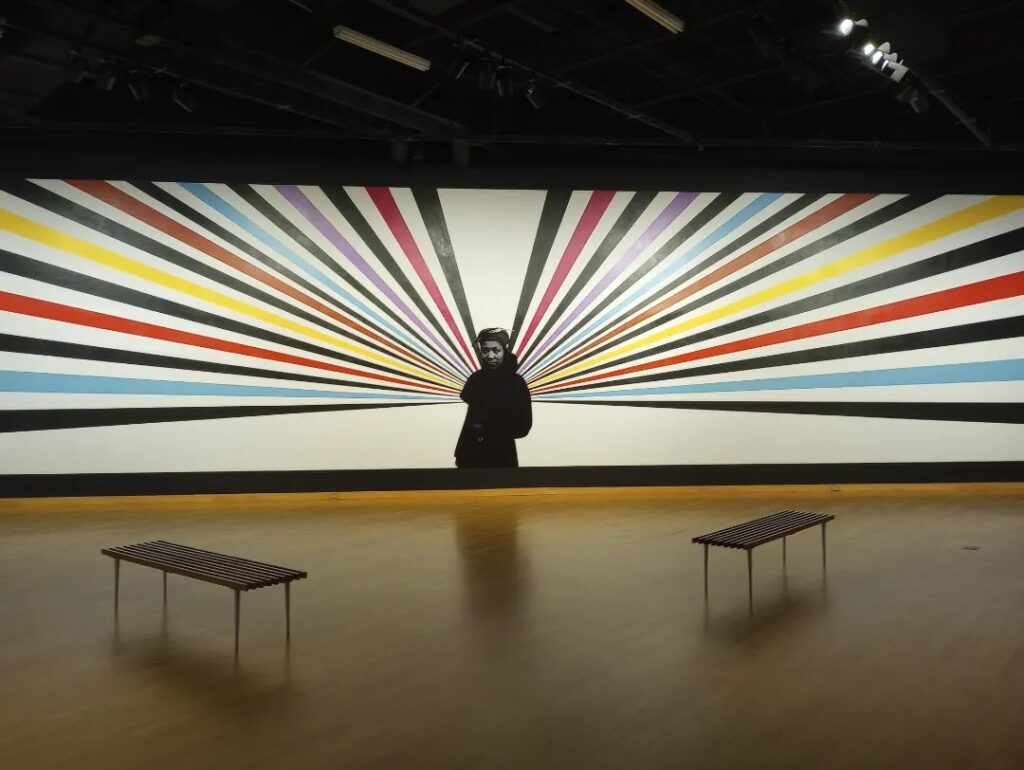I’d been feeling scraped out lately so I decided to go to a museum and picked the USF Contemporary Art Museum (CAM). I didn’t know what was showing but I like “contemporary art,” as a genre, and I’ll likely be back because the exhibition was very well done.
The exhibit is by artist Rico Gatson, a Black artist working with Black history; the exhibit was called Visible Time.
I went in and talked for like 15 minutes to the guy at the front desk, getting the lay of the land. I think I was the only person in there at the time (I saw a few others), and he wanted to be able to share the excessive amounts of information he contained, but did not regularly get to share, so I stopped and listened. Of course I was glad that I did. I got:
- A brief history of the art museum and why it exists at all, as opposed to there just being an art department (it’s a research tool for the art department and they have one show every year for the grad students so they can learn how to put on shows).
- An explanation that the museum has a special relationship to the print department, which specializes in making art prints because the print shop was at the forefront of same at some point in the past (this now escapes me because I forgot to take notes). I also have a giant poster by the artist and his softcover exhibition book for free, because I held still long enough.
- A QR code for a playlist to listen to during the exhibition. (It is excellent! Highly recommend.)
- An explanation of why the USF campus has so much public art (there was a matching grant thingy where you could use like half a percent of the total construction budget for a public building on public art, plus the grant match, which means they cool public art all over campus; I also got a map but it was Too Freaking Hot today to walk around outside.
- Jokes about not eating some of the art, and a story about an exhibition that involved very minty used chewing gum in which they had to actually advise people not to eat the art.
The exhibition was small but good. I didn’t get it at first. It seemed very simple. I took some photos (the guy at the desk said they were allowed) but they don’t do it justice. There were a number of smaller pieces, like Saints of Black History. Audre Lorde, Sidney Portier. Black-and-white photographs with rays of light emanating from them. Okay.
But then I turned around a corner, and the entire room was filled with an image of author Zora Neale Hurston, and I got it. Huge. Vibrant. Just her everyday self, turned into a holy icon, angel wings made of radiant bands of light. No feathers. Just laser-sharp light.
Everything popped into place, the music (I was listening to the playlist), the colors, the lines.
Then I turned another corner and got shook again, a series of three flat-screen TVs with three-to-ten minute films on them, deconstructions of different Hollywood movies. Foxy Brown and The Good The Bad and the Ugly; The Birth of a Nation; The French Connection. The images were made kaleidoscopic, radiating from a central point in reflected symmetry that made the nonsense apparent. Guns and violence against Black people; a disgusting revelation of how a white director turned Black fear into near-pornography; the way it was easier to center a white person in a movie about injustice to Black people than it was to center a Black one. I think.
I watched them, trying to take photos of the images as they raced past. It was useless. I got the photos but they’re meaningless at stills. Nobody said it was okay to take video so I didn’t.
The last room (I said the place was small) was a screening theater. I stayed there for over an hour, watching and rewatching a film about Emmett Till called Four Stations. Again I tried to take photos, but they really didn’t mean anything. So I sat down and sketched with a drawing marker. I feel like those images caught more of what I was seeing and feeling, even if they don’t look like the images I saw. Everything flashed by quickly. Most of it was wordless.
The place where supposedly Emmett Till whistled at a white woman. The town, today. The courtroom. The white woman’s white house, decrepit barn. The place where his murderers dumped his body. The sacred grief of his mother.
Music played, “Music Is The Healing Force Of The Universe,” Albert Ayler.
I’m sure I don’t get it enough. But I watched and sketched and watched and sketched and when I left I went to two different parks and I noticed most of the people there were white, but not all. It was uncomfortable. I let it be.
I ended up at an ice cream shop run by two white ladies, with only white people sitting at the tables. But it was good, the kind of place that should be next to a swimming pool. Fried things, hot dogs, ice cream twisted and dipped. I got chili cheese tots and a blackberry shake, which tasted like grease and salt and sweetened flour glue. One of the ladies sounded neither male nor female, but made of stones. She wished me a blessed day as I left. I felt weird about it.
One of the songs on the playlist was by Miles Davis, “Black Satin” from the 1972 album On the Corner. I love this song. It was on one of the shorter films, overlapping stills from Birth of a Nation showing a Black man’s eyes bulging out. I may carry the images with me for a while. But in response to the stupid, ham-fisted evil of Birth of a Nation is the supreme and subtle chaos of Miles Davis. I put on the whole album; I hadn’t heard it before. Again.
Again.
How did they make this? How did it all flow together? How much of it was planned? How did they agree to take turns, to shift the sound from one moment to the next, to bring forth that vibe? Those echoes? That sacred space?
Suddenly it makes sense, not the how of it, and not really the why of it, but at least a glimpse into the what of it. There’s a track on the playlist called “Message From Albert/New Grass” by Albert Ayler and Soul Singers that is pure noisy chaos.
Before I went to the exhibit, I would not have been able to make sense of it. At all.
It is pain, it is joy, it is “because I will make it”; it is the sound that is heard when our lies are spoken; it is truth.
At the end of the song someone speaks of the need for universal harmony.
“Repent. Pray again, and Repent. For your sake.”
My brain has new contexts now; I can hear that awful sound better than I could before. Amen.



